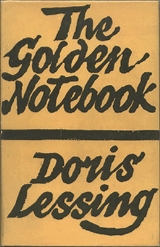
The Golden Notebook
Encyclopedia
The Golden Notebook is a 1962
novel
by Doris Lessing
. This book, as well as the couple that followed it, enters the realm of what Margaret Drabble in The Oxford Companion to English Literature
has called Lessing's "inner space fiction", her work that explores mental and societal breakdown. The book also contains a powerful anti-war and anti-Stalinist message, an extended analysis of communism and the Communist Party in England from the 1930s to the 1950s, and a famed examination of the budding sexual and women's liberation movements. The Golden Notebook has been translated into a number of other languages.
In 2005, the novel was chosen by TIME
magazine as one of the one hundred best English-language novels from 1923 to present.
1962 in literature
The year 1962 in literature involved some significant events and new books.-Events:*January 7 - In an article in the New York Times Book Review, Gore Vidal calls Evelyn Waugh "our time's first satirist."...
novel
Novel
A novel is a book of long narrative in literary prose. The genre has historical roots both in the fields of the medieval and early modern romance and in the tradition of the novella. The latter supplied the present generic term in the late 18th century....
by Doris Lessing
Doris Lessing
Doris May Lessing CH is a British writer. Her novels include The Grass is Singing, The Golden Notebook, and five novels collectively known as Canopus in Argos....
. This book, as well as the couple that followed it, enters the realm of what Margaret Drabble in The Oxford Companion to English Literature
The Oxford Companion to English Literature
The Oxford Companion to English Literature first published in 1932, edited by the retired diplomat Sir Paul Harvey , was the earliest of the Oxford Companions to appear...
has called Lessing's "inner space fiction", her work that explores mental and societal breakdown. The book also contains a powerful anti-war and anti-Stalinist message, an extended analysis of communism and the Communist Party in England from the 1930s to the 1950s, and a famed examination of the budding sexual and women's liberation movements. The Golden Notebook has been translated into a number of other languages.
In 2005, the novel was chosen by TIME
Time
Time is a part of the measuring system used to sequence events, to compare the durations of events and the intervals between them, and to quantify rates of change such as the motions of objects....
magazine as one of the one hundred best English-language novels from 1923 to present.
Plot summary
The Golden Notebook is the story of writer Anna Wulf, the four notebooks in which she keeps the record of her life, and her attempt to tie them all together in a fifth, gold-colored notebook. The book intersperses segments of an ostensibly realistic narrative of the lives of Molly and Anna, and their children, ex-husbands and lovers—entitled Free Women—with excerpts from Anna's four notebooks, coloured black (of Anna's experience in Central Africa, before and during WWII, which inspired her own bestselling novel), red (of her experience as a member of the Communist Party), yellow (an ongoing novel that is being written based on the painful ending of Anna's own love affair), and blue (Anna's personal journal where she records her memories, dreams, and emotional life). Each notebook is returned to four times, interspersed with episodes from Free Women, creating non-chronological, overlapping sections that interact with one another. This post-modernistic styling, with its space and room for "play" engaging the characters and readers, is among the most famous features of the book, although Lessing insisted that readers and reviewers pay attention to the serious themes in the novel.Major themes
All four notebooks and the frame narrative testify to the above themes of Stalinism, the Cold War and the threat of nuclear conflagration, and women's struggles with the conflicts of work, sex, love, maternity, and politics.External links
- "Full text of Doris Lessing's The Golden Notebook, with annotations for an internet reading group" - website created as an experiment in online collaborative reading
- Guarded welcome - an article by Doris LessingDoris LessingDoris May Lessing CH is a British writer. Her novels include The Grass is Singing, The Golden Notebook, and five novels collectively known as Canopus in Argos....
- Fragmentation and Integration. A Critical Study of Doris Lessing, The Golden Notebook by Nan Bentzen Skille, Universitetet i Bergen 1977
- "But it is the same book": Ways of Reading Doris Lessing's The Golden Notebook. A Podcast by Sabanci University.

